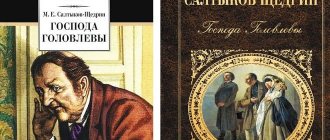Aesopian language: what it means, examples from literature
Aesopian language is a special style of narration that uses a set of allegorical techniques - allegories, allusions, periphrases, irony, etc.
to express a specific thought. Often used to disguise, hide, veil the true thoughts of the author or the names of the characters.
Fabulist Aesop
The term “Aesopian language” itself was introduced by Saltykov-Shchedrin.
Little is known about the life of Aesop himself. The sage Aesop lived in the 6th century BC in Ancient Greece. The historian Heradotus claimed that Aesop was born on the island of Samos, but a century later Heraclides of Pontus stated that Aesop was from Thrace. The ancient Greek writer Aristophanes was also interested in his life.
In the end, based on some facts and references, a certain legend about the sage Aesop developed. He was lame, a holy fool, very inquisitive, smart, quick-witted, cunning and resourceful. Being a slave of a businessman from the island of Samos, Aesop could not speak openly, freely about what he thought and saw.
He composed parables (as they would later be called fables), where the characters were animals and objects, but their character and manners were presented in such a way that human nature was easily captured. Aesop's allegorical fables ridiculed human vices: stupidity, stinginess, greed, envy, pride, vanity and ignorance. For his service, the fabulist was released and gained freedom.
According to legend, the death of the sage was tragic. While in Delphi, Aesop turned several residents of the city against him with his caustic remarks. And they, in retaliation, planted stolen golden bowls from the temple on him, sounded the alarm about the loss and indicated which of the pilgrims could supposedly steal them. After a search, the cup was found and Aesop was stoned. Later, his innocence was proven and the descendants of the then murderers were forced to pay vira - a fine for killing a free person.
Aesopian language - the meaning of phraseology
The phraseology “Aesopian language” is quite widely used today. Aesopian languages will be called speech full of hints, omissions and allegories; or a deliberately veiled meaning of what was said.
Aesopian language in literature
Aesopian language is widespread in such literary genres as fable, fairy tale, legend, in the genres of journalism, political satire.
Examples of Aesopian language can be found in the works of Krylov, Saltykov-Shchedrin, Garshin, Pushkin, Lermontov, Chernyshevsky, Dobrolyubov, Nekrasov, Kurochkin.
Aesopian language became an integral element in the works of times of strict censorship, when writers could not openly express their thoughts and assess current events, which often contradicted the official ideology.
A striking example of the use of Aesopian language can be called the story-parable written by J. Orwell in a satirical manner “Animal Farm”. It depicts the historical events of revolutionary Russia in 1917. The main characters are animals that live on Mr. Jones's English farm. Each animal represents a social class. The conditions in which they live seem unfair to them, so the animals decide to make a revolution and create an equal, classless, fair existence. However, equality was never achieved.
Examples from Saltykov-Shchedrin
Among Russian writers, Saltykov-Shchedrin most vividly used the language of Aesop. Let us turn to his allegorical work “The History of a City”. The writer introduces the reader to the city of Foolov and its inhabitants - the Foolovites. He describes them as lazy, inactive, unable to make decisions themselves, wanting to quickly find someone who will decide for them and take responsibility for their fate.
At the very beginning, the Foolovites go in search of the prince, and give preference to foreign rulers, admit their own inconsistency: “Our land is great and abundant, but there is no order in it...”.
Reading the work, you understand that the author describes not a specific city, but the whole of Russia and its people. You can also find more obvious correspondences: Negodyaev - Paul I, Benevolensky - Speransky, Gloomy-Burcheev - Arakcheev, Grustilov - Alexander I. And the ending of the work is symbolic: just as unsuccessful are the efforts of Gloomy-Burcheev to stop the flow of the river, it is also in vain to try to interfere with the decisions of the tyrants standing in power.
Saltykov-Shchedrin’s Aesopian language is also present in his fairy tale “Gudgeon” about a cowardly fish, which symbolizes the cowardice and selfishness of people who remain indifferent to everything except themselves.
In “The Tale of How One Man Fed Two Generals,” the author talks about the obedience of the people through images of an allegorical image of a man who, on orders, began to twist a rope to tie himself; or about the stupidity and short-sightedness of officials who are far from pressing everyday problems, who believe that French rolls grow on trees.
Definition
Aesopian language is called allegory. This is how they define a thought that for some reason cannot be expressed directly. Most often, the ban is associated with censorship considerations.
In everyday life, adults sometimes resort to Aesopian language when they need to pronounce this or that information in the presence of children.
Even with the help of hints, two girlfriends can communicate, whom the husband or young man of one of them, who has become attached to their company, is forced to listen to. They coo “about their own things, about women’s things,” but not every word is comfortable to say in front of a man. So you have to encrypt.
It turns out that Aesopian language is a secret conversation between two parties, bypassing the third, uninitiated party.
Otherwise, allegorical expressions in language are called euphemisms. They are often used for ethical and aesthetic reasons. An example of a funny, absurd euphemism is given by N.V. Gogol in the poem “Dead Souls,” when one of the ladies says about a bad-smelling scarf that it “behaves badly.” Euphemisms surround us everywhere, without them life would not be so pleasant. For example, if students did not use the euphemism “you can go out” during the lesson, but specified exactly where they were going out, the class would savor the details of what was happening for a long time.
Euphemisms surround us everywhere, without them life would not be so pleasant. For example, if students did not use the euphemism “you can go out” during the lesson, but specified exactly where they were going out, the class would savor the details of what was happening for a long time.
Aesopian language of Saltykov-Shchedrin
A distinctive feature of the writer’s works is the use of artistic allegorical language, which the author himself calls Aesopian, after the famous fabulist Aesop, a slave who was forced to describe his statements not in direct speech, but in a veiled form.
Reading the writer’s works sometimes seems somewhat difficult due to his use of strange, too sophisticated expressions, but this is explained by the writer’s heavy dependence on tsarist censorship and the author’s desire to convey to readers his own opinion, independent of the ruling power.
The use of the “slave manner” in the original form of literary language, as the writer called his allegorical work, allows the author to expose with particular accuracy and force the vices and shortcomings of the existing autocratic system, beautifully and easily bypassing censorship.
The use of the fairy-tale-fantastic form of works allows the writer to convey deep realism, introducing satirical sharpening and exaggeration into the actual content of fairy tales, and showing exceptional ingenuity in the use of allegorical techniques. Bringing fantastic content to a realistically absurd state is one of the manifestations of the use of the Aesopian manner in the writer’s fairy tales.
In addition, one of the special features of Aesopian language seems to be the special use of skipping words or an entire text part, giving the reader the opportunity to come up with further developments of events.
Lowering the tonal color in the narrative is also one of the techniques of the Aesopian style, combined with the conscious creation of double-meaning texts, consisting in the alternation of direct meaning and the author's ideas.
In the presentation of fairy tales, the writer uses his characteristic poisonous satire, including in the text of the work allegorical expressions, accidental slips, omissions, irony and the mask of a positive storyteller, which the author presents in a complex artistic interweaving. The author's style allows us to consider the depicted object from an unexpected and witty point of view, as well as the features and signs of fairy tale heroes illustrated in an unusual form remain in the memory for a long time after reading, since the use of hidden thoughts makes it possible to increase speech power, while naked text, on the contrary, retains the reader's imagination.
The use of witty Aesopian language techniques in fairy tales, which make it possible to more vividly illustrate artistic perception, helps the writer in creating deep, generalized images of reality, as well as in the correct understanding of current events, which he allegorically examines through a literary magnifying glass, emphasizing human relationships, exposing the vicious, the idle lifestyle of the autocracy, mercilessly exploiting the impoverished population.
Aesopian language of Saltykov-Shchedrin
Several interesting essays
The policeman Derzhimorda, along with the rest of the numerous heroes, is one of the secondary characters of the work.
Now, the phenomenon of a youth idol is becoming somehow strange. Among my peers, I regularly see hobbies for some unworthy individuals who are practically nothing and at the same time are chosen as an idol to follow.
Many people like to use the word honor, but not everyone is ready to defend it in our time. Cowardice causes dishonor, disrespect, indifference and laziness, forcing us not to defend our interests and the interests of people close to us
In this work, the author talks about many things that take place in our lives. In it, he reflects on such things as hypocrisy, deceit, corruption, unjustified ignorance.
A.S. Griboedov wrote the immortal work “Woe from Wit,” which predicted a model of social behavior after the war period. At this time, people were divided into two groups and each had their own views on future life.
Aesop's Language for Dummies
Let's talk today about the language of Aesop.
Aesop's language is one of the first linguistic programming languages. It originated in an ancient Greek community, where one of the participants, having heard the verbal diarrhea of the local oracle, said: “E. There is a problem, but there is no word.” Thus a new language appeared.
Aesop's Language is an explicitly typed object-oriented language, where the type of an object is uniquely determined by its name. An object can have several names. Examples of names indicating the same object: birds, falcon, woodpecker.
Aesop easily copes with the polymorphism of an object, even if the object, like a virus, mutates over time or inherits itself and avoids the attention of the garbage collector a.k.a. Heracles
A remarkable property of language is self-documentation. In the example above, no comments are needed to understand what object the names refer to.
Compilation of programs in the Aesop language is carried out on the user's side using the interpretation method. One of the disadvantages of the language is the need to master the subject area, otherwise interpretation errors are possible. But after gaining the minimum required level of knowledge, errors are practically eliminated.
One of the strongest properties of Aesop's language is reusability. Old and almost forgotten statements from other languages, when used in the context of Aesop with minimal changes, take on new life.
Examples: Center, center, sokel hurts! You can see the bird by its droppings - I can guess the woodpecker by its three assholes! - And I’ll take two!
One of the prominent programmers in the language of Aesop was I. Krylov, who gushed with implementations of the algorithms of his teacher Lafontaine. Krylov’s favorite objects were various woodpeckers, but in order not to fall under the obsolete and incorrectly working garbage collector, he had to use other designations. Let's use River Engineering to restore some of Krylov's source texts:
From the problem of four non-musical woodpeckers:
. And you, hollow, no matter what your name, will not turn into songbirds.
From the stoned woodpecker program
(Editor’s note: in the last lines, Krylov, unfortunately, gave wishful thinking, hoping in vain for the collector’s garbage)
In conclusion, here are a few Aesop exercises for your own interpretation:
A woodpecker is not a bird; woodpecker is a diagnosis. The woodpecker is Sokelu's friend, comrade and avatar. If you are afraid of woodpeckers, do not open a corporation. Don't wait for a woodpecker to attack you. Leave on time.
Source
Aesopian language in the works of Saltykov-Shchedrin (fairy tales, fables)
Aesopian language, or allegory, is a form of artistic speech dating back to time immemorial. It is not for nothing that it is associated with the name of Aesop, the semi-legendary creator of the Greek fable, who apparently lived in the sixth century BC. As legend has it, Aesop was a slave, and therefore could not openly express his beliefs and in fables based on scenes from the lives of animals, he depicted people, their relationships, advantages and disadvantages. However, Aesopian language is not always a necessary measure, the result of a lack of determination; There are people for whom an indirect, allegorical manner of expressing thoughts becomes like a magnifying glass that helps them see life more deeply. Among Russian writers, the most notable talents who used Aesopian language are I. A. Krylov and M.
E. Saltykov-Shchedrin. But if in Krylov’s fables the allegory is “deciphered” in morality (let’s say Demyanov’s ear is likened to the creations of a graphomaniac writer), then in the works of Saltykov-Shchedrin the reader himself must understand what kind of reality lies behind the writer’s half-fairy-tale, half-fantastic world. Here is the “History of a City” entirely based on allegory.
What is the city of Foolov? A typical, “statistically average” Russian provincial town? No. This is a conventional, symbolic image of all of Russia; it is not for nothing that the writer emphasizes that its borders expand to the entire country: “The pasture lands of Byzantium and Foolov were so adjacent that the Byzantine herds almost constantly mixed with Foolov’s, and incessant bickering arose from this.” Who are the Foolovites?
As sad as it may be to admit, the Foolovites are Russians. This is evidenced, firstly, by the events of Russian history, which, although presented in a satirical light, are still easily recognizable. Thus, the struggle of the Slavic tribes (Polans, Drevlyans, Radimichi, etc.), known from the chronicles.
) and their subsequent unification are parodied by Saltykov-Shchedrin in his depiction of how the bunglers were at enmity with the neighboring tribes - the bow-eaters, frog-eaters, and rukosuyami. In addition, one is forced to see Russians in Foolovites by such qualities noted by the writer as laziness, inactivity, inability to be courageous builders of one’s own life, and hence the passionate desire to entrust one’s destiny to someone, just so as not to make responsible decisions oneself. One of the first pages of Foolov's story is the Search for the Ruler. After the distant ancestors of the Foolovians kneaded the Volga with oatmeal, then bought a pig for a beaver, greeted the crayfish with the ringing of bells, exchanged the father for a dog, they decided to find a prince, but only a stupid one: “A stupid prince is probably even better for us.” will! Now we put the gingerbread in his hands: chew, and don’t bother us!
“Through this story depicted by Saltykov-Shchedrin, the chronicle legend about the invitation of the Varangian princes to Russian soil is clearly visible; Moreover, the chronicler emphasizes that the Russians decide on foreign power over themselves, having become convinced of their own insolvency: “Our land is great and abundant, but there is no order in it. “In addition to the above-mentioned allegories, there are also more specific correspondences in “The History of a City”: Negodyaev - Paul I, Benevolensky - Speransky, Ugryum-Burcheev - Arakcheev. In the image of Grustilov, who raised the tribute from the farmstead to five thousand a year and died of melancholy in 1825, a satirical portrait of Alexander I is given. However, it cannot be said that bitter laughter at Russian fate testifies to the historical pessimism of the writer. The ending of the book speaks of the powerlessness of Gloomy-Burcheev to stop the flow of the river, in which one can see an allegory that the efforts of tyrants to stop the flow of life are ineffective.
It is also necessary to understand Aesopian language when reading the tales of Saltykov-Shchedrin. For example, the fairy tale “The Wise Minnow,” which tells about a fish trembling in fear for its life, of course, goes beyond the scope of “animal life”: the minnow is the symbolic embodiment of a cowardly, selfish man in the street, indifferent to everything except himself. “The story of how one man fed two generals” is also full of allegories. A man twisting a rope to tie himself on the orders of the generals personifies the slavish obedience of the people.
The generals think that French buns grow on trees; This satirical detail allegorically depicts how far away major officials are from real life. Saltykov-Shchedrin said about himself: “I am an Aesop and a student of the censorship department.” But, probably, Shchedrin’s allegory is not only a necessity caused by censorship considerations.
Of course, Aesopian language helps to create a deep, generalized image of reality, and therefore better understand life itself.
/* ads 468 */ Liked the article - “Aesopian language in the works of M. E. Saltykov-Shchedrin ? Click and save.
Other phraseological units
Belgorod jelly
Misleading, cunning deception for the greater good.
Beat with your forehead
To ask something from a superior person, to bow low.
Wasted on soap
An exchange that does not bring benefits, a transaction leading to a worsening of the current state of affairs.
Neither light nor dawn
Very early, still in the dark, before morning.
All phraseological units
Aesopian language in the works of M. E. Saltykov-Shchedrin
Aesopian language, or allegory, is a form of artistic speech dating back to time immemorial. It is not for nothing that it is associated with the name of Aesop, the semi-legendary creator of the Greek fable, who apparently lived in the sixth century BC. As legend has it, Aesop was a slave, and therefore could not openly express his beliefs and in fables based on scenes from the lives of animals, he depicted people, their relationships, advantages and disadvantages. However, Aesopian language is not always a necessary measure, the result of a lack of determination; There are people for whom an indirect, allegorical manner of expressing thoughts becomes like a magnifying glass that helps them see life more deeply. Among Russian writers, the most notable talents who used Aesopian language are I. A. Krylov and M. E. Saltykov-Shchedrin. But if in Krylov’s fables the allegory is “deciphered” in morality (let’s say Demyanov’s ear is likened to the creations of a graphomaniac writer), then in the works of Saltykov-Shchedrin the reader himself must understand what kind of reality lies behind the writer’s half-fairy-tale, half-fantastic world.
Here is the “History of a City” entirely based on allegory. What is the city of Foolov? A typical, “average” Russian provincial town? No. This is a conventional, symbolic image of all of Russia; it is not for nothing that the writer emphasizes that its borders expand to the entire country: “The pasture lands of Byzantium and Foolov were so adjacent that the Byzantine herds almost constantly mixed with Foolov’s, and incessant bickering arose from this.” Who are the Foolovites? As sad as it may be to admit, the Foolovites are Russians. This is evidenced, firstly, by the events of Russian history, which, although presented in a satirical light, are still easily recognizable. Thus, the struggle of the Slavic tribes (Polyans, Drevlyans, Radimichi, etc.), known from the chronicles, and their subsequent unification are parodied by Saltykov-Shchedrin in his depiction of how the bunglers were at enmity with the neighboring tribes - the bow-eaters, frog-eaters, and hand-swords. In addition, one is forced to see Russians in Foolovites by such qualities noted by the writer as laziness, inactivity, inability to be courageous builders of one’s own life, and hence the passionate desire to entrust one’s destiny to someone, just so as not to make responsible decisions oneself. One of the first pages of Foolov's story is the search for a ruler. After the distant ancestors of the Foolovites kneaded the Volga with oatmeal, then bought a pig for a beaver, greeted the crayfish with the ringing of bells, exchanged the father for a dog, they decided to find a prince, but only a stupid one: “A stupid prince will probably be even better for us!” Now we’re putting the cake in his hands: chew it, but don’t bother us!” Through this story depicted by Saltykov-Shchedrin, the chronicle legend about the invitation of the Varangian princes to Russian soil is clearly visible; Moreover, the chronicler emphasizes that the Russians decide on foreign power over themselves, having become convinced of their own insolvency: “Our land is great and abundant, but there is no order in it. ”
In addition to the above-mentioned allegories, “The History of a City” also contains more specific correspondences: Negodyaev - Paul I, Benevolensky - Speransky, Ugryum-Burcheev - Arakcheev. In the image of Grustilov, who raised the tribute from the farmstead to five thousand a year and died of melancholy in 1825, a satirical portrait of Alexander I is given. However, it cannot be said that bitter laughter at Russian fate testifies to the historical pessimism of the writer. The ending of the book speaks of the powerlessness of Gloomy-Burcheev to stop the flow of the river, in which one can see an allegory that the efforts of tyrants to stop the flow of life are ineffective.
It is also necessary to understand Aesopian language when reading the tales of Saltykov-Shchedrin. For example, the fairy tale “The Wise Minnow,” which tells about a fish trembling in fear for its life, of course, goes beyond the scope of “animal life”: the minnow is the symbolic embodiment of a cowardly, selfish man in the street, indifferent to everything except himself. “The story of how one man fed two generals” is also full of allegories. A man twisting a rope to tie himself on the orders of the generals personifies the slavish obedience of the people. The generals think that French buns grow on trees; This satirical detail allegorically depicts how far away major officials are from real life.
Saltykov-Shchedrin said about himself: “I am an Aesop and a student of the censorship department.” But, probably, Shchedrin’s allegory is not only a necessity caused by censorship considerations. Of course, Aesopian language helps to create a deep, generalized image of reality, and therefore better understand life itself.
Who was Aesop really?
In the introduction to our article, we already said that Aesop is an ancient author who became famous - for the most part - for his fables. However, it is necessary to specify knowledge about this ancient Greek writer. There is very little information left about Aesop’s biography, so it is not possible to completely reconstruct the poet’s life story. Aesop was in slavery - this is known for sure (in particular, Herodotus, an equally eminent ancient author, wrote about this). But only now the years of the writer’s life have sunk into oblivion. Aesop's host came from Phrygia, a country located in Asia Minor. Then Aesop was given freedom. Taking advantage of the period of freedom, the poet entered the service of the court of the king of Lydia. The ruler's name was Croesus, the legendary Lydian ruler. After Lydia, Aesop went to the Delphic region, but the priests of the Delphic Temple accused the fabulist of sacrilege. The punishment followed was cruel - Aesop was thrown from high cliffs. But a remark should be made: this is only one version of the biography of the ancient Greek author.
However, Aesop was not only a fabulist. The poet paid attention to collecting instructive and witty stories, which were the very fables that were passed down from generation to generation orally. Today we would call it folklore. Based on the collected material, the writer created his own works. Aesop is a witty and wise man, the first author to go down in history as a fabulist. Before the Middle Ages, there was no single collection of Aesop’s texts, so in fact it is difficult to judge how real the figure of Aesop is and how legendary it is. Literary scholars admit that most of the works included in that medieval collection of Aesopian texts are, rather, retellings, or even do not belong to Aesop at all. Ancient Greek has become today regarded more as a legendary and symbolic person. There are many anecdotes and funny stories about Aesop. In this context, the personality of the fabulist is similar to the figure of Socrates, the philosopher of Ancient Greece. Aesop's works later formed the basis for similar fables by other talented writers: La Fontaine, Krylov, Skovoroda, Glebov, etc.
What did Aesop write about?
The poems of the one who invented the original language, alas, have not survived to this day. However, the author's adaptations of the works of the ancient poet were so loved by many creators that they began to remake the works of the ancient Greek author in their own way. Reworks of Aesop left by other masters of the ancient style - Phaedrus, Avian and Babrius - have survived to this day. Some literary scholars ask the question: did Aesop even exist? Arguments favor Aesop, because 426 fables have survived that are attributed to the ancient poet, but other scholars argue that the collection contains rather the creations of other authors.
Herodotus described Aesop as an ugly man in appearance, but with a beautiful soul. Aesop had the unique ability to convey age-old wisdom using an allegorical method. At the time the fabulist lived, the fable was characterized by an oral form, but the verbal power, influence of the fable and the power of instructive potential preserved the contents of fables for centuries. “Aesop's Fables” is the title of a book that was compiled in the Middle Ages. This book was used as a textbook for rhetoric classes in medieval schools. Later, fables were transformed into literature accessible to all readers.
More details about the themes of Aesop's fables
Aesop's goal is to make people look at themselves with different eyes through figurative images of the animal world. An outside perspective is what humanity needs to see and realize its vices. What is humanity's biggest sin, according to the ancient fabulist? Selfishness, stupidity, cunning and deceit, greed and envy. An Aesopian fable is an expression of a certain life episode.
Before the readers, one after another, images appear of a pig digging the roots of an oak tree that gives it tasty acorns, peasant sons digging up their father’s vineyard, trying to find a hidden treasure, etc. However, all these images are fraught with hidden meanings: Aesop is trying to show readers the value of respect for one’s neighbor , labor and ability to work.
The ancient author demonstrates the destructive nature of negative human feelings, lies, frivolity, ill-will, ingratitude, talkativeness, etc.
With the help of a powerful tool - allegory - the fabulist conveys to the public the importance of the ability to appreciate what you have, and not strive to conquer more, entering into an obviously unequal battle with the strongest enemy. Aesop is also interested in the problem of gaining experience through one's own mistakes. At the same time, mistakes are not a sin, they are a way to learn new things and improve yourself. And the main values in this process are patience and the ability to work. Thus, Aesop rightfully received the “title” of the founder of the fable. Each work contains a conclusion at the end - the instructive meaning of the fable, the moral of the text.
Allegorical form of artistic speech in the works of M.E. Saltykova-Shchedrin
Aesopian language, or allegory, is a form of artistic speech dating back to time immemorial. It is not for nothing that it is associated with the name of Aesop, the semi-legendary creator of the Greek fable, who apparently lived in the sixth century BC. As legend has it, Aesop was a slave, and therefore could not openly express his beliefs and in fables based on scenes from the lives of animals, he depicted people, their relationships, advantages and disadvantages. However, Aesopian language is not always a necessary measure, the result of a lack of determination; There are people for whom an indirect, allegorical manner of expressing thoughts becomes like a magnifying glass that helps them see life more deeply. Among Russian writers, the most notable talents who used Aesopian language are I. A. Krylov and M. E. Saltykov-Shchedrin. But if in Krylov’s fables the allegory is “deciphered” in morality (let’s say Demyanov’s ear is likened to the creations of a graphomaniac writer), then in the works of Saltykov-Shchedrin the reader himself must understand what kind of reality lies behind the writer’s half-fairy-tale, half-fantastic world.
Here is the “History of a City” entirely based on allegory. What is the city of Foolov? A typical, “average” Russian provincial town? No. This is a conventional, symbolic image of all of Russia; it is not for nothing that the writer emphasizes that its borders expand to the entire country: “The pasture lands of Byzantium and Foolov were so adjacent that the Byzantine herds almost constantly mixed with Foolov’s, and incessant bickering arose from this.” Who are the Foolovites? As sad as it may be to admit, the Foolovites are Russians. This is evidenced, firstly, by the events of Russian history, which, although presented in a satirical light, are still easily recognizable. Thus, the struggle of the Slavic tribes (Polyans, Drevlyans, Radimichi, etc.), known from the chronicles, and their subsequent unification are parodied by Saltykov-Shchedrin in his depiction of how the bunglers were at enmity with the neighboring tribes - the bow-eaters, frog-eaters, and hand-swords. In addition, one is forced to see Russians in Foolovites by such qualities noted by the writer as laziness, inactivity, inability to be courageous builders of one’s own life, and hence the passionate desire to entrust one’s destiny to someone, just so as not to make responsible decisions oneself. One of the first pages of Foolov's story is the search for a ruler. After the distant ancestors of the Foolovites kneaded the Volga with oatmeal, then bought a pig for a beaver, greeted the crayfish with the ringing of bells, exchanged the father for a dog, they decided to find a prince, but only a stupid one: “A stupid prince will probably be even better for us!” Now we’re putting the cake in his hands: chew it, but don’t bother us!” Through this story depicted by Saltykov-Shchedrin, the chronicle legend about the invitation of the Varangian princes to Russian soil is clearly visible; Moreover, the chronicler emphasizes that the Russians decide on foreign power over themselves, having become convinced of their own insolvency: “Our land is great and abundant, but there is no order in it. ”
In addition to the above-mentioned allegories, “The History of a City” also contains more specific correspondences: Negodyaev - Paul I, Benevolensky - Speransky, Ugryum-Burcheev - Arakcheev. In the image of Grustilov, who raised the tribute from the farmstead to five thousand a year and died of melancholy in 1825, a satirical portrait of Alexander I is given. However, it cannot be said that bitter laughter at Russian fate testifies to the historical pessimism of the writer. The ending of the book speaks of the powerlessness of Gloomy-Burcheev to stop the flow of the river, in which one can see an allegory that the efforts of tyrants to stop the flow of life are ineffective.
It is also necessary to understand Aesopian language when reading the tales of Saltykov-Shchedrin. For example, the fairy tale “The Wise Minnow,” which tells about a fish trembling in fear for its life, of course, goes beyond the scope of “animal life”: the minnow is the symbolic embodiment of a cowardly, selfish man in the street, indifferent to everything except himself. “The story of how one man fed two generals” is also full of allegories. A man twisting a rope to tie himself on the orders of the generals personifies the slavish obedience of the people. The generals think that French buns grow on trees; This satirical detail allegorically depicts how far away major officials are from real life.
Saltykov-Shchedrin said about himself: “I am an Aesop and a student of the censorship department.” But, probably, Shchedrin’s allegory is not only a necessity caused by censorship considerations. Of course, Aesopian language helps to create a deep, generalized image of reality, and therefore better understand life itself.
AESOP'S LANGUAGE AS AN ARTISTIC DEVICE (On the example of the works of M. E. Saltykov-Shchedrin)
Aesopian language as a method of artistic expression of thought has been popular at all times. Its founder, as you can easily guess from the name, was the wandering ancient Greek fabulist Aesop. For the first time in the history of world literature, he used allegory and omission to hide the direct meaning of his fables.
In particular, Aesop depicted people in the form of animals. His works exposed human vices, but since the author used the language of allegory, those debunked by him had no direct reason for indignation and discontent towards the powerless slave that Aesop was. Thus, the Aesopian language served as a defense against the attacks of numerous ill-wishers. In Russia, Aesopian language was widely used by satirists. An explanation for this can be found in the famous dictionary of Vladimir Dahl. He wrote: “Censorship strictures caused an unprecedented flowering of the Aesopian language. Russian writers, due to censorship oppression, were forced to write in Aesopian language" (Dal V.
Explanatory dictionary of the living Great Russian language. In 4 volumes. M., 1994. T. 4, p.
1527). The most prominent of them are I. A. Krylov, famous for his fables, and, of course, beloved by many, M. E. Saltykov-Shchedrin with his evil and merciless satire, designed to “send everything that is obsolete to the kingdom of shadows.” The tales of M. E. Saltykov-Shchedrin in the history of Russian literature marked the beginning of a new and extremely important stage, which determined the entire future fate of the satirical movement in this genre. The writer identified and used the main artistic, linguistic, intonation, and visual techniques that make up the essence of the revealing tale. In the satires written by various authors in subsequent decades, up to M. Gorky’s “Russian Fairy Tales,” his influence is felt. M. E. Saltykov-Shchedrin published the first three fairy tales back in 1869, among them was one of the most famous - “The Tale of How One Man Fed Two Generals.” The writer turned to this genre as an experienced, established writer: “Provincial Sketches” had already been written. A certain pattern in the appearance of fairy tales in the writer’s work can be clearly seen in how the author developed and matured such artistic techniques inherent in the fairy-tale genre as fantasy, exaggeration, allegory, Aesopian language, and so on. At the same time, fairy tales were for M. E. Saltykov-Shchedrin an experience of a qualitatively new artistic language, an experience that was brilliantly applied later when writing “The History of a City” in 1869-1870. Thus, these works are created using the same artistic techniques, such as hyperbole, grotesque and Aesopian language. The latter includes “speaking” names and images of animals, taken by the author from Russian folklore, but filled with a different meaning. Saltykov-Shchedrin’s fairy-tale form is conventional and allows the writer to express a far from fairy-tale, bitter truth and open the reader’s eyes to complex issues of the country’s socio-political life. For example, in the fairy tale “The Wise Minnow,” Saltykov-Shchedrin paints an image of a frightened man in the street who “doesn’t eat, doesn’t drink, doesn’t see anyone, doesn’t share bread and salt with anyone, and only saves his hateful life.” The moral issues raised in this tale concern us to this day. In the works of M. E. Saltykov-Shchedrin, the reader will inevitably encounter a comparison of social groups of the writer’s contemporary Russia and various animals, birds and even fish: the peasantry, seeking truth and help from the powers that be, is depicted as a raven-petitioner (“The Raven-petitioner” ); the government leaders of the autocracy are shown by the author in the image of an eagle-patron of the arts (“Eagle-Patron”); and the bear governor looks like cruel warriors who take away the last things from the people under their control for the sake of high-profile affairs (“Bear in the Voivodeship”). In “The History of a City,” each name parodies specific vices and negative aspects of Russian reality. For example, Brudasty, or “Organchik,” is the personification of government stupidity and narrow-mindedness; Ferdyshchenko - the arrogance and hypocrisy of the ruling circles, and the stubborn idiot Gloomy-Burcheev, who made an insane attempt to fight the elements, with nature (remember his desire to turn the river back), which personifies the very endless and continuous history of man, embodies the autocracy, which was pretty rotten by the middle of the nineteenth century making pitiful attempts to survive. In my opinion, M. E. Saltykov-Shchedrin uses Aesopian language for the same purposes as Aesop himself, that is, to, firstly, protect himself, and secondly, to protect his works from being seized by the ubiquitous censorship, which , despite the satirist’s amazing skill in using allegorical speech, constantly haunted him: “. and cut and trimmed. and completely banned.” So, Aesopian language as an artistic device is a most valuable invention in the field of literature, allowing writers, firstly, not to change their principles, and secondly, not to give a clear reason for anger to the powers that be.








